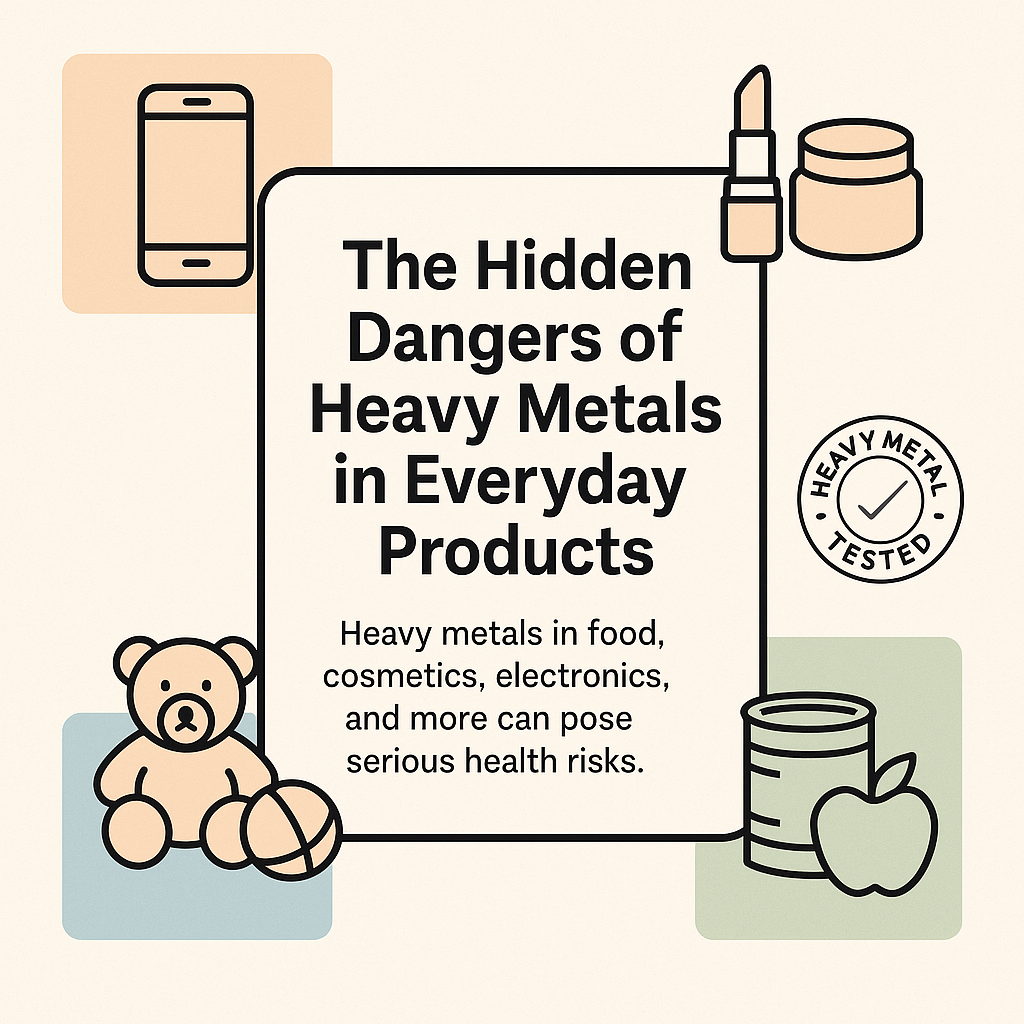
The Hidden Dangers of Heavy Metals in Everyday Products
Heavy metals in food, toys, and cosmetics can harm your health. Learn how to avoid toxic exposure and choose certified safe products for your family.
Introduction: A Silent Threat in Our Homes
When we think of toxins, we often picture industrial waste or polluted rivers—not our favorite snack, our child’s toy, or the lipstick in our purse. Yet hidden among these everyday items could be a dangerous culprit: heavy metals.
Heavy metals like lead, mercury, arsenic, and cadmium occur naturally in the earth, but in high concentrations, they can be extremely harmful to human health. These metals are increasingly found in consumer products—from electronics and cosmetics to food and baby toys—posing a silent threat to our families, particularly children and pregnant women.
This article explores where these contaminants hide, how they affect our health, and most importantly, what you can do to avoid them. Because your health—and your family’s—should never be compromised by the products you trust.
What Are Heavy Metals and Why Are They Harmful?
Heavy metals are a group of dense metals and metalloids with known toxic effects. While trace amounts of some (like zinc and iron) are essential to the body, others—like lead and arsenic—serve no beneficial purpose and are harmful even in small doses.
The concern lies in their ability to bioaccumulate, meaning they build up in the body over time. Prolonged exposure can lead to serious, irreversible health issues—especially when ingestion, inhalation, or skin contact is frequent or unnoticed.
Everyday Products That May Contain Heavy Metals
You may be surprised to learn how many common items can be contaminated with toxic metals:
- Electronics: Smartphones, laptops, and batteries often contain lead, cadmium, and mercury. Improper disposal can cause these metals to leach into soil and water.
- Cosmetics: Lipsticks, eyeliners, and powders have tested positive for lead, arsenic, and chromium—sometimes due to color additives or contaminated raw materials.
- Toys and Jewelry: Imported children’s toys, costume jewelry, and even crayons have been found to contain unsafe levels of lead and cadmium.
- Food Products: Rice, baby food, spices, and protein powders can contain traces of arsenic, mercury, or lead due to contaminated soil, water, or processing equipment.
- Cookware and Utensils: Certain ceramic glazes, non-stick coatings, or aluminum cookware may leach heavy metals into food over time.
Health Risks of Heavy Metal Exposure
Heavy metals are particularly dangerous because their symptoms often appear slowly and mimic other health issues. This can delay diagnosis and treatment. For vulnerable groups—children, pregnant women, and the elderly—the effects are even more severe:
- Children: Exposure to lead or mercury can impair brain development, reduce IQ, and lead to behavioral issues. Even low levels can cause developmental delays.
- Pregnant Women: Heavy metals can cross the placental barrier, harming fetal development and increasing the risk of miscarriage or birth defects.
- Adults: Chronic exposure can cause organ damage (liver, kidneys, brain), hormonal imbalances, cancer, and weakened immune function.
How to Spot Potentially Contaminated Products
Unfortunately, heavy metal contamination is not always obvious. That’s why proactive awareness is key:
- Read Labels Carefully: Check for vague ingredient lists, especially in imported food or cosmetics.
- Be Cautious of Unregulated Imports: Products made outside countries with strong safety regulations may bypass standard testing.
- Watch for Recalls: Government agencies like the FDA or CPSC often release lists of recalled items due to contamination—stay informed.
- Ask Brands About Testing: Reputable companies should be transparent about their safety standards and testing protocols.
Why Third-Party Testing and Certification Matters
When a product is certified by an independent, third-party heavy metal testing organization, it means the item has undergone rigorous lab analysis for safety. Unlike in-house or self-declared claims, third-party testing ensures objective, science-based results.
Certification labels give consumers peace of mind that a product has met or exceeded safety thresholds for toxic metals. This is especially critical for:
- Baby food and formula
- Dietary supplements
- Health and beauty products
- Pet food
- Cookware and food containers
Look for trusted certification seals—like Heavy Metal Tested™—that validate a product’s safety based on transparent lab results.
How You Can Protect Yourself and Your Family
Here are a few practical steps you can take to reduce your risk of exposure:
- Choose Certified Products: Prioritize brands that participate in heavy metal testing and certification.
- Limit Risky Items: Avoid cheap costume jewelry for children, unverified imported goods, or unregulated supplements.
- Use Water Filters: Heavy metals like lead can be present in tap water. Use a certified filter that removes heavy metals.
- Practice Safe Disposal: Properly dispose of old electronics, batteries, and paints to prevent environmental contamination.
- Stay Informed: Follow product recall alerts and updates from public health agencies.
Conclusion: Safer Products Start with Awareness
Heavy metals are invisible threats that can infiltrate the most trusted parts of our daily lives—from our kitchens and makeup bags to our children’s toy bins. But awareness, education, and informed choices can turn the tide.
By choosing products that are third-party tested and certified for heavy metal safety, you’re not just protecting your health—you’re sending a message to the marketplace that transparency and safety matter.
Look for the Heavy Metal Tested™ label. Choose products that care as much about your family’s well-being as you do.
Because safety isn’t a luxury—it’s a right.